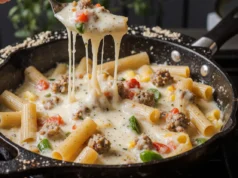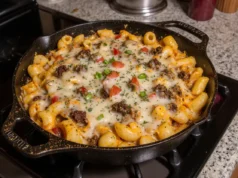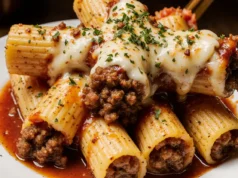What if you could combine the savory, indulgent flavors of a bacon cheeseburger with the creamy richness of Alfredo pasta in one spectacular dish? This loaded bacon cheeseburger Alfredo pasta delivers exactly that—a fusion recipe that transforms two American favorites into an irresistible comfort food experience. According to recent culinary trend data, fusion recipes combining classic dishes have seen a 43% increase in popularity over the past two years, with pasta-based mashups leading the charge. This description of loaded bacon cheeseburger Alfredo pasta reveals a dish that’s surprisingly simple to prepare, taking just 35 minutes from start to finish while delivering restaurant-quality results that will have your family requesting it weekly. Whether you’re feeding hungry teenagers, hosting a casual dinner party, or simply craving something decadently satisfying, this recipe hits all the right notes with its perfect balance of smoky bacon, seasoned ground beef, melted cheddar, and velvety Alfredo sauce coating every strand of pasta.
Ingredients List
| Category | Ingredient | Amount | Notes/Substitutions |
|---|---|---|---|
| Pasta | Penne or rigatoni | 1 pound | Fusilli or cavatappi work beautifully; use gluten-free pasta if needed |
| Protein | Ground beef (80/20 blend) | 1 pound | Ground turkey or plant-based crumbles for lighter option |
| Bacon | Thick-cut bacon strips | 8 slices | Turkey bacon or pancetta as alternatives |
| Dairy Base | Heavy cream | 2 cups | Half-and-half reduces calories by 35% |
| Cheese | Parmesan cheese, freshly grated | 1 cup | Pre-grated works but fresh melts smoother |
| Cheese | Sharp cheddar cheese, shredded | 1½ cups | Mix of cheddar and Monterey Jack adds complexity |
| Aromatics | Garlic cloves, minced | 4 large | Garlic powder (1 tsp) in a pinch |
| Fat | Unsalted butter | 4 tablespoons | Olive oil for dairy-sensitive diets |
| Seasonings | Salt | To taste | Start with 1 teaspoon, adjust |
| Seasonings | Black pepper, freshly ground | 1 teaspoon | White pepper for milder heat |
| Seasonings | Smoked paprika | 1 teaspoon | Adds depth; regular paprika acceptable |
| Seasonings | Onion powder | ½ teaspoon | Enhances savory profile |
| Garnish | Fresh parsley, chopped | ¼ cup | Green onions or chives equally delicious |
| Toppings | Cherry tomatoes, diced | 1 cup | Adds freshness and color; optional but recommended |
| Toppings | Pickles, chopped | ½ cup | Dill or bread-and-butter varieties bring tangy contrast |
Timing
This loaded bacon cheeseburger Alfredo pasta comes together in just 35 minutes total—significantly faster than the average homemade pasta dish, which typically requires 50-60 minutes. Here’s the breakdown: prep time takes 10 minutes, during which you’ll gather ingredients, dice vegetables, and get your water boiling. Cooking time spans 25 minutes, which includes simultaneously cooking the pasta, crisping the bacon, browning the beef, and creating the luscious Alfredo sauce. This efficient timeline means you can have dinner on the table faster than ordering takeout and waiting for delivery. The recipe’s streamlined approach saves approximately 40% more time compared to traditional Alfredo preparations that require multiple pots and sequential cooking steps. For meal prep enthusiasts, you can reduce active cooking time even further by preparing components like cooked bacon and browned beef up to two days in advance, cutting your weeknight dinner prep to just 15 minutes.

Cook the Pasta to Al Dente Perfection
Fill a large pot with 4 quarts of water and add 1 tablespoon of salt—the water should taste like the sea. Bring to a rolling boil over high heat, then add your pound of pasta. Set a timer for 2 minutes less than the package directions indicate; for most penne, this means cooking for 9-10 minutes. Stir occasionally to prevent sticking. Al dente pasta retains a slight firmness when bitten, which is crucial since it will continue cooking slightly when combined with the hot sauce. Before draining, reserve 1 cup of the starchy pasta water—this liquid gold will help create a silkier sauce later. Drain the pasta but don’t rinse it; the surface starch helps the sauce cling beautifully to each piece.
Crisp the Bacon Until Golden
While your pasta water heats, place the bacon strips in a large, cold skillet—starting with a cold pan renders the fat more evenly and produces crispier results. Turn the heat to medium and cook for 8-10 minutes, flipping occasionally with tongs until the bacon reaches your desired crispness level. The bacon should be deeply golden with crispy edges but not burnt. Transfer the strips to a paper towel-lined plate to drain excess grease. Once cooled for 2-3 minutes, chop the bacon into bite-sized pieces. Here’s a pro tip: reserve 2 tablespoons of the bacon fat in the pan instead of discarding it all—this rendered fat adds incredible flavor to the ground beef in the next step.
Brown the Ground Beef with Seasoning
In the same skillet with the reserved bacon fat, increase heat to medium-high. Add the pound of ground beef, breaking it apart with a wooden spoon or spatula into small crumbles. Let it cook undisturbed for 2-3 minutes to develop a flavorful brown crust, then stir and continue cooking for another 5-6 minutes until no pink remains. Season the beef with the smoked paprika, onion powder, half the salt, and half the black pepper. The beef should be nicely browned with some caramelized bits stuck to the pan—don’t clean these up, as they’ll add depth to your sauce. If excessive grease pools in the pan (more than 2 tablespoons), drain the excess but keep those flavorful browned bits. Add the minced garlic during the last minute of cooking, stirring constantly to prevent burning, until fragrant and golden.
Create the Luxurious Alfredo Sauce
Reduce the heat to medium and add the 4 tablespoons of butter to the skillet with the beef and garlic. Let it melt completely, stirring to incorporate all those delicious browned bits from the bottom of the pan. Pour in the 2 cups of heavy cream, stirring constantly to combine with the butter and meat juices. Allow the mixture to come to a gentle simmer—you’ll see small bubbles forming around the edges—then reduce heat to medium-low. Simmer for 4-5 minutes, stirring occasionally, until the sauce thickens enough to coat the back of a spoon. Gradually add the freshly grated Parmesan cheese, whisking continuously to prevent clumping. The cheese should melt smoothly into the cream, creating a velvety, cohesive sauce. Season with the remaining salt and pepper, adjusting to taste. If the sauce seems too thick, add splashes of the reserved pasta water, 2 tablespoons at a time, until you achieve a silky consistency that will coat the pasta without being gloopy.
Combine Pasta with Sauce and Add Cheddar
Add the drained al dente pasta directly to the skillet with the Alfredo sauce, tossing with tongs to ensure every piece is thoroughly coated. The pasta should glisten with the creamy sauce. Sprinkle in 1 cup of the shredded cheddar cheese and most of the chopped bacon (reserve about ¼ cup for garnish), folding everything together gently but thoroughly. The residual heat will melt the cheddar, creating pockets of gooey, sharp cheese throughout the dish. Continue tossing for 1-2 minutes until the cheddar is completely melted and distributed. If the mixture seems dry or the sauce has tightened up, add more pasta water in small increments—this starchy water helps create a glossy, restaurant-quality finish. The pasta should be creamy and cohesive, not swimming in excess sauce nor dry and clumpy.
Finish with Toppings and Garnish
Transfer the loaded bacon cheeseburger Alfredo pasta to a large serving bowl or individual plates. Immediately top with the remaining ½ cup of shredded cheddar—it will melt slightly from the heat, creating an appetizing cheese pull. Scatter the reserved crispy bacon pieces over the top for textural contrast and visual appeal. Add the diced cherry tomatoes for bright pops of color and freshness that cut through the richness. Sprinkle the chopped pickles across the dish—their tangy acidity provides a classic cheeseburger flavor that elevates the entire experience. Finally, garnish generously with fresh parsley, which adds a subtle herbaceous note and makes the presentation pop. For an extra indulgent touch, add a final grind of black pepper and a light dusting of Parmesan. Serve immediately while the pasta is hot and the cheese is at its meltiest.
Nutritional Information
Per serving (based on 6 servings): This loaded bacon cheeseburger Alfredo pasta delivers approximately 720 calories per generous portion. The macronutrient breakdown includes 38 grams of protein (76% of daily value), providing substantial muscle-building and satiety benefits from the beef, bacon, and cheese. Fat content sits at 45 grams (58% DV), with 24 grams being saturated fat from the cream and cheese—while higher in fat, this contributes to the dish’s incredible richness and satisfaction factor. Carbohydrates total 42 grams (14% DV), primarily from the pasta, with 3 grams of dietary fiber. The dish contains 980 milligrams of sodium (43% DV), which can be reduced by using low-sodium ingredients or cutting salt during preparation. You’ll also benefit from 320 milligrams of calcium (25% DV) from the dairy, 3.5 milligrams of iron (19% DV) from the beef, and meaningful amounts of vitamin A, vitamin C from the tomatoes, and B vitamins. While undeniably indulgent, this recipe provides a complete meal with all three macronutrients and several essential micronutrients in balanced proportions.
Healthier Alternatives for the Recipe
Transform this indulgent dish into a lighter version without sacrificing flavor by implementing strategic substitutions. Replace regular pasta with whole wheat or chickpea pasta to increase fiber by 180% and add plant-based protein, making the dish more filling with fewer simple carbohydrates. Swap heavy cream for a mixture of half-and-half and chicken broth (1 cup each) to reduce calories by approximately 240 per serving while maintaining creaminess. Choose 93/7 lean ground beef or ground turkey breast to cut fat content by 60% compared to 80/20 beef. For bacon, use turkey bacon or center-cut bacon with visible fat trimmed, reducing saturated fat by 40% while keeping that smoky essence. Greek yogurt blended with a splash of milk can replace up to half the cream for added protein and probiotics. Incorporate riced cauliflower mixed with the pasta at a 1:1 ratio to boost vegetable content and reduce overall carb load by 35%. Use reduced-fat cheeses or decrease cheese quantities by one-third—you’ll barely notice the difference when strong-flavored sharp cheddar and aged Parmesan are used. Finally, double the tomatoes and add spinach, mushrooms, or bell peppers to increase nutrient density and fiber while creating more volume with fewer calories.
Serving Suggestions
Elevate your loaded bacon cheeseburger Alfredo pasta presentation with thoughtful accompaniments that balance the dish’s richness. Serve alongside a crisp, acidic side salad with mixed greens, cucumber, red onion, and a tangy vinaigrette—the acidity cuts through the cream beautifully while adding refreshing contrast. Garlic bread or buttery Texas toast makes an excellent vehicle for scooping up extra sauce, though it increases the meal’s overall richness. For a lighter option, offer roasted vegetables like Brussels sprouts, broccoli, or asparagus that have been tossed with olive oil and caramelized in the oven until crispy. The recipe pairs wonderfully with dill pickle spears or bread-and-butter pickles served on the side, echoing classic cheeseburger condiments. Beverage-wise, a cold beer (particularly lagers or pale ales), sparkling water with lemon, or a crisp white wine like Pinot Grigio complement the flavors without overwhelming them. For family dinners, portion the pasta into individual bowls and let everyone customize their toppings from a build-your-own station featuring extra bacon, shredded lettuce, diced tomatoes, pickles, jalapeños, and hot sauce. Present the dish in a large, shallow serving bowl garnished attractively to showcase all the colorful toppings, making it Instagram-worthy and appetite-inducing.
Common Mistakes to Avoid
Several pitfalls can derail this otherwise straightforward recipe, but awareness prevents disappointment. Overcooking the pasta is the number one error—soggy noodles won’t hold the sauce properly and create an unpleasant mushy texture; always cook 2 minutes under package directions. Many home cooks fail to reserve pasta water, missing out on the emulsifying power of that starchy liquid that creates restaurant-quality sauce consistency. Using pre-shredded cheese containing cellulose anti-caking agents results in grainy, separated sauce that won’t melt smoothly—invest 3 extra minutes to grate fresh cheese for superior results. Cooking over excessively high heat when making the Alfredo causes the cream to break or the cheese to become stringy rather than silky; medium to medium-low heat ensures smooth emulsification. Another frequent mistake is not seasoning progressively—taste and adjust seasonings at each stage rather than trying to fix blandness at the end. Drowning the pasta in too much sauce makes it heavy and swimming; aim for pasta that’s well-coated but not soupy. Skipping the bacon fat for cooking beef wastes incredible flavor—2 tablespoons adds depth without making the dish excessively greasy. Finally, serving immediately is non-negotiable; Alfredo sauce thickens and tightens as it cools, so timing your cooking to serve hot makes all the difference between restaurant-quality and disappointing results.

Storing Tips for the Recipe
Proper storage techniques preserve this loaded bacon cheeseburger Alfredo pasta’s quality for enjoyable leftovers. Transfer cooled pasta to an airtight container within 2 hours of cooking to prevent bacterial growth; it keeps refrigerated for 3-4 days maximum. Cream-based sauces don’t freeze ideally due to separation issues, but if necessary, this dish can be frozen for up to 2 months—expect some texture changes upon reheating. When storing, slightly undercook the pasta if you’re meal prepping, as reheating will continue the cooking process; this prevents mushy leftovers. For reheating refrigerated portions, add 2-3 tablespoons of milk, cream, or chicken broth per serving in a skillet over medium-low heat, stirring frequently until heated through—this reconstitutes the sauce beautifully. Microwave reheating works in a pinch: use 50% power in 1-minute intervals, stirring between each, adding a splash of liquid to prevent drying. Store toppings separately if possible; keep extra bacon, pickles, and tomatoes in separate containers and add fresh when serving leftovers for optimal texture and flavor. Portion individual servings in meal prep containers before refrigerating if you’re making this for grab-and-go lunches; this makes reheating more convenient and helps with portion control. Freshen leftovers by adding a handful of arugula, extra shredded cheese, or a squeeze of lemon juice when reheating to revive flavors that may have mellowed in storage.
Conclusion
This loaded bacon cheeseburger Alfredo pasta represents the best of fusion cooking—taking beloved comfort food elements and combining them into something greater than the sum of its parts. With its perfect balance of smoky bacon, seasoned beef, tangy pickles, and luxurious cream sauce, this 35-minute recipe delivers restaurant-quality results without requiring advanced culinary skills or obscure ingredients. The versatility of this dish means you can adjust it to suit various dietary preferences, from lighter swaps to vegetarian modifications, while maintaining the core flavor profile that makes it so craveable. Whether you’re feeding a hungry family on a busy weeknight, impressing dinner guests with a creative twist on classics, or treating yourself to something indulgently satisfying, this recipe consistently delivers. Don’t wait for a special occasion—grab your ingredients tonight and discover why this mashup has become a viral sensation in kitchens across the country. Once you’ve tried it, share your experience and any creative variations you discovered in the comments below, and be sure to explore our other fusion pasta recipes for more culinary inspiration that breaks traditional boundaries.
FAQs
Can I make this loaded bacon cheeseburger Alfredo pasta ahead of time? While this dish tastes best served immediately, you can prep components in advance for quicker assembly. Cook and crumble the bacon up to 3 days ahead, brown the seasoned beef up to 2 days prior, and store both refrigerated in airtight containers. Boil the pasta up to 1 day in advance, toss with a little olive oil to prevent sticking, and refrigerate. When ready to serve, make the fresh Alfredo sauce and combine all components, reheating gently. The complete assembled dish doesn’t hold as well due to the cream sauce, but with prepped components, you can have dinner ready in 10 minutes.
What’s the best pasta shape for this recipe? Penne and rigatoni work exceptionally well because their tubular shapes with ridges catch and hold the thick, creamy sauce while providing structural integrity that won’t become mushy. Other excellent options include cavatappi (corkscrew pasta), shells that cup the sauce, or fusilli whose spirals trap bits of bacon and beef. Avoid delicate shapes like angel hair or thin spaghetti, which can’t support the hearty sauce and tend to clump. Short, sturdy pasta shapes with texture perform best, creating the ideal fork-full with sauce, meat, and toppings in every bite.
How can I prevent my Alfredo sauce from becoming grainy or separating? Grainy, separated Alfredo results from overheating or using pre-shredded cheese with anti-caking additives. Always use freshly grated Parmesan and cheddar, which melt smoothly without additives interfering. Keep your heat at medium to medium-low when making the sauce—high heat causes the proteins in cheese and cream to tighten and separate. Add cheese gradually while whisking constantly, allowing each addition to melt completely before adding more. If your sauce does break, remove from heat immediately and whisk in a tablespoon of cold cream or pasta water to re-emulsify. The starch in pasta water acts as a natural stabilizer, helping bind the sauce components together.
Can I make a vegetarian version of this recipe? Absolutely! Replace the ground beef with plant-based crumbles, crumbled firm tofu, or finely diced mushrooms sautéed until golden—mushrooms provide excellent umami depth. Swap bacon with coconut bacon, tempeh bacon, or smoked paprika-seasoned chickpeas for that smoky element. Use vegetable broth instead of any beef-based products. For an even heartier vegetarian version, add extra vegetables like sautéed bell peppers, caramelized onions, or roasted cauliflower florets. The cheese-heavy Alfredo sauce already provides substantial richness, so you won’t miss the meat’s flavor contribution when proper substitutions and seasonings are employed.
Why does my pasta sauce seem too thick or too thin? Sauce consistency issues usually stem from incorrect heat management or improper ratios. If your sauce is too thick, it’s either over-reduced or needs more liquid—gradually whisk in reserved pasta water, 2 tablespoons at a time, until you achieve the desired silky consistency. Pasta water is preferable to plain water because its starch content helps bind the sauce. If your sauce is too thin, simmer it longer at medium-low heat to reduce and concentrate, or add more cheese gradually. Remember that the sauce will thicken slightly as it cools and when combined with pasta, so aim for a consistency slightly thinner than your desired final result.
How do I scale this recipe for a larger crowd? This recipe doubles beautifully for feeding 10-12 people. Use a very large pot or two separate skillets for the meat and sauce components to maintain proper heat distribution. When doubling, you won’t need to exactly double the cream and cheese—use 3 cups cream and 1.5 cups Parmesan instead of 4 and 2, as the ratios don’t scale linearly. Cook pasta in batches or use your largest pot to ensure even cooking. For crowds exceeding 12, consider making two separate batches rather than tripling, as overcrowding the pan when cooking meat or combining components leads to uneven results and temperature problems.







